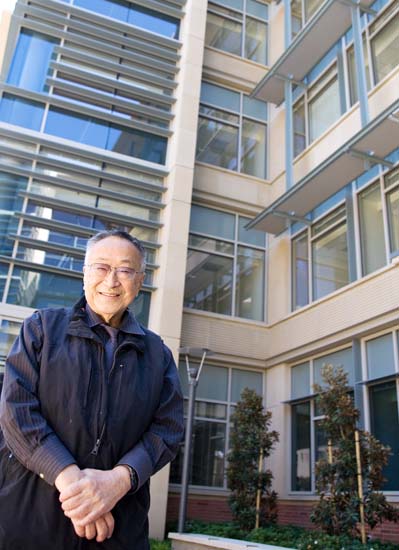Professor Emeritus Paul Terasaki donates $50 million to go toward new life sciences building

Retired UCLA Professor Paul Terasaki stands in front of UCLA’s new Terasaki Life
Sciences Building on Charles E. Young Drive near the Botany Building.
By James Barragan
May 19, 2010 11:13 p.m.
The newly constructed Life Sciences Building will be named in honor of Professor Emeritus Paul Terasaki, who taught at UCLA for more than half a century and recently donated $50 million to the College of Letters and Science on May 13.
The Terasaki Life Sciences Building, set to open in October, will include 33 laboratories where scientists will conduct research using the latest technology, integrating cell biology, neuroscience, genomics and stem cell research.
Terasaki’s donation, the largest ever given to the College, will include $48 million that will pay for the construction of the new building, which has been built near Hershey Hall.
The remaining $2 million will go toward endowing the Paul I. Terasaki Chair in Surgery at the David Geffen School of Medicine. These funds will also support two postdoctoral fellowships in transplantation.
Though funding for the project had not yet been found, construction for the new building was already under way because Chancellor Gene Block and the life sciences department saw a compelling need for modern laboratories.
Victoria Sork, dean of the Division of Life Sciences at UCLA, said that without a donation of this sort the life sciences department would have had to incur the debt.
“We received money from the state for a portion of the building, but it was insufficient to cover the entire cost,” Sork said. “Of course, we have been hoping to find a donor to help pay for the building, and we are fortunate to benefit from Dr. Terasaki’s generosity.”
The donation caps Terasaki’s 51-year relationship with UCLA, when he entered as a transfer student in 1948 and attained his bachelor’s degree, master’s degree and doctorate in zoology. Terasaki later became a professor of surgery in 1969 conducting his pioneering research in the field of organ transplantation while at UCLA.
In 1964, he developed a test that became the international standard method for tissue typing. For the past four decades, this method, which assesses compatibility, has been used to type all kidney, heart, liver, pancreas, lung and bone marrow recipients and donors.
For Terasaki though, at the age of 12 all of this success would have seemed unimaginable. During World War II, Terasaki and his family were moved to a relocation camp, causing him to realize for the first time that he was Japanese American.
“Being Japanese American means that things that affect Japan also affect me,” Terasaki said. “When the war started, I wasn’t involved because I was born here, and I was only 12 years old, but it affected me and my family. I realized that I am Japanese American.”
Terasaki said that the experience did not have a great effect on him as a child except for the poor schooling he received because of a lack of teachers. But for adults such as his parents who had to sell everything they had for almost nothing, life after the camp was a difficult readjustment.
After the war, his family decided to leave California and only returned in 1948 when Terasaki began his long career at UCLA.
But Terasaki’s ties to UCLA go further than just his own experience here. Three of his four children also attended his alma mater, spending a total of 22 years here.
Despite his breakthrough in the tissue-typing method and working with Nobel Prize winners such as Peter Medawar, considered the founder of the transplantation field, Terasaki remains humble and rooted in speaking about his accomplishments.
“I worked a bit harder than some other people, but I don’t know,” he said. “I mean there are a lot of people who have accomplished a lot more than I did.”
Although Terasaki retired from UCLA more than a decade ago, he still has strong ties to the university. He expressed hopes that UCLA will continue to grow as it has in the past, and he hopes that it will maintain its position as a top university in the world. His donation will help fund an area of study that he was immersed in during his time here.
“I spent most of my life there,” he said. “I guess I wouldn’t consider anything else or any other place.”

